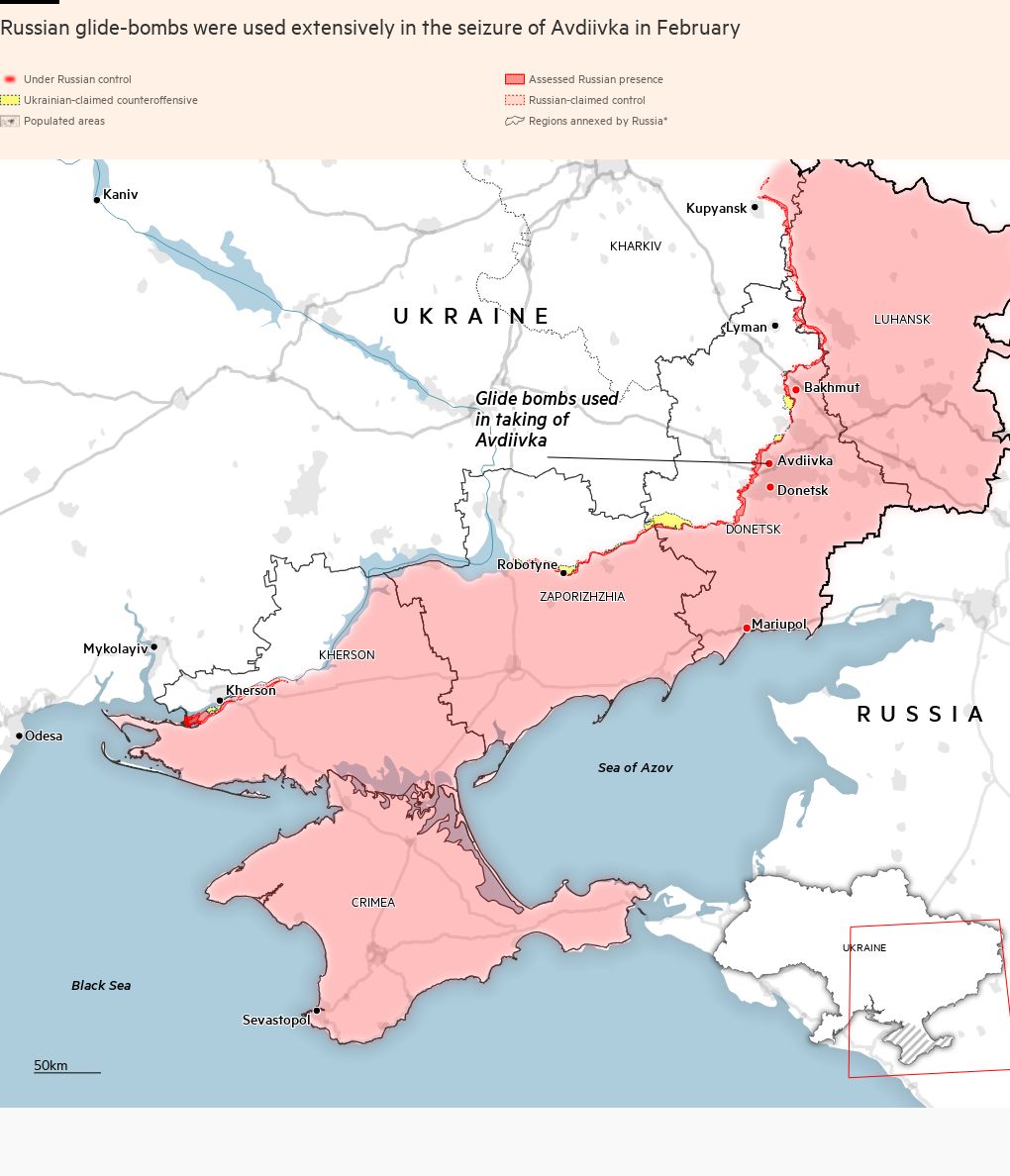The Russian air force is stepping up its use of Soviet-era weapons that have been retrofitted for 21st-century warfare and are pounding Ukrainian forces, pulverising towns and giving Moscow an advantage on the battlefield.
“The experience of the past months and weeks shows that the enemy has significantly increased aircraft activity, using guided air bombs that destroy our positions,” Ukrainian commander-in-chief Oleksandr Syrsky said in March.
The guided weapons are commonly referred to as “glide bombs” and consist of decades-old projectiles that would typically be dropped from Su-34 and Su-35 warplanes directly over targets. By adding cheap pop-out wings and a satellite navigation system, these former “dumb bombs” can now be launched by Russian bombers deep behind the front line and out of reach of Ukraine’s air-defence systems.
“For them, it is much cheaper than using hundreds of thousands of artillery shells, when one of these bombs will demolish several buildings,” said Vlad, a 27-year-old soldier serving in the eastern Donetsk region.
The glide bombs can carry between 500kg and 1.5 tonnes of explosives for over 60km, leaving craters up to 20m wide and 6m deep.
“They are very scary, very lethal,” said Bohdan, another soldier in Donetsk. “Even a kilometre away, the blast rips the doors of buildings off their hinges.”

They are so destructive that Ukrainian analysts with Deep State, a group close to the defence ministry, have called them a weapon for which Kyiv’s forces have “practically no countermeasures”.
Ukrainian foreign minister Dmytro Kuleba told the Financial Times that his country’s soldiers “are being massively and I would say even routinely attacked by guided aerial bombs that wipe out our positions”.
The Russians have attacked Ukraine with around 3,500 such guided aerial bombs just this year, according to Ukrainian defence officials, a 16-fold increase over 2023. In the third week of March alone, Russia “launched over 700 guided aerial bombs,” President Volodymyr Zelenskyy said.
“They are very simple in essence, so you cannot jam them, you cannot hide from them — the only way to protect yourself from them is to shoot down the bomber that carries this bomb,” explained Kuleba.
Yet to achieve that, Ukraine needs significantly more modern air defence systems.
The International Institute for Strategic Studies, a London-based think-tank, said in a report published this month that “the growing number of glide-bomb attacks are indicative of the scarcity of air defence weapons”.

This shortage is in part due to delays in European military aid and the US Congress holding up a $60bn package for Kyiv, it added.
US-made F-16 fighter jets which have been promised by allies could also help Ukraine fend off Russian bombers. But they are unlikely to be delivered before midsummer, according to Kuleba.
These delays are hurting Ukraine. Zelenskyy said last month that Russia could launch a new major offensive in late spring or early summer. And Ukrainian officials told the FT that Moscow’s glide bombs would probably be used to blast paths through the new fortifications Kyiv is rushing to build to stave off the advance of Russian forces.
In the last week of March, Kharkiv, Ukraine’s second-largest city, was hit by two “unified multipurpose” gliding bombs which have a range of up to 90km. It was the first time Kharkiv had been hit by aerial bombs as opposed to missiles and drones since the full-scale invasion.
The Russian air force has played a limited role since the full-scale invasion in February 2022. Indeed, the war has largely been defined by land battles, in what one Ukrainian military official described as resembling “the First World War plus the latest technologies” — trenches, but with drones.

But in recent months, as the back-and-forth fighting slowed and the opposing armies dug in, the air war over Ukraine has heated up.
In March, Russia fired hundreds of cruise and ballistic missiles at Ukrainian energy facilities and civilian infrastructure. The strikes plunged Ukraine’s Kharkiv into days of darkness and threatened the destruction of hydroelectric power plants in the cities of Kaniv and Zaporizhzhia.
Meanwhile, Kyiv has struck a dozen oil refineries and a drone factory deep inside Russia as well as warships and command facilities of the Russian Black Sea fleet in Crimea.
Now Russia’s air force is beginning to play a pivotal role and turning the tide of the war in its favour, experts say. And it is the development of glide bombs that has opened the door to do so.
The Institute for the Study of War wrote in a recent assessment that the Russian military had used “mass glide-bomb strikes to tactical effect in their seizure of Avdiivka in mid-February”. Hundreds of glide bombs razed the town in Donetsk region and forced Ukrainian troops to retreat.
“These bombs completely destroy any position. All buildings and structures simply turn into a pit after the impact of just one,” Egor Sugar, a Ukrainian soldier who fought in Avdiivka, wrote on X. “And they drop 60-80 on us in one day.”
Michael Kofman, a military analyst at the Carnegie Endowment for International Peace, said that the sheer number of glide bombs together with their destructive force had an impact on soldiers’ morale.
“If you see the crater that two 500-kilogram bombs make, they will make an impression on you,” he said.
The head of the armed forces has also cited glide bombs as a major reason for ordering his troops to retreat from Avdiivka, which handed Moscow its first notable battlefield win in nearly a year.
“Due to constant bombardment by guided aerial bombs, the integrity of our defence was broken, which gave the enemy the opportunity to gradually advance,” Syrsky said.
Russia is now ramping up production of glide bombs and updating the 500-kilogram FAB-500 and the 1,500-kilogram FAB-1500 bombs.
Earlier this month, Russian defence minister Sergei Shoigu visited a plant in Nizhny Novgorod region where he inspected production lines. The defence ministry said that the factory had “increased the production of FAB-500 aerial bombs many times over [and] doubled the production of the FAB-1500.”
The ministry said it had also begun the “mass production of the FAB-3000,” an even larger, 3,000-kilogram bomb that can also be fitted with wings and guiding systems.
However, western experts and even popular pro-Kremlin military bloggers on Telegram who operate channels dedicated to Russia’s air force have expressed scepticism about the FAB-3000. Some have called it impractical, as it could be carried only by Tupolev Tu-22M bombers.
Oleksiy Melnyk, a retired Ukrainian air force commander and now co-director of foreign policy and international security studies at the Razumkov Centre, a Kyiv-based think-tank, said the Russian modernisations are inexpensive compared to the high cost of many modern weapons, especially cruise missiles, which can cost several million dollars each.
While glide bombs are not as precise as ballistic cruise missiles, they can still hit “within 10 or 20 metres” of their target and cause severe damage, Melnyk said.
Experts believe Kyiv’s future successes on the battlefield may depend on its ability to defend against glide bombs. That means getting more western help, and fast.
“Kyiv is confronted by the threat that an attritional war in the air domain will increasingly favour Russia without adequate support from the US and its allies,” the IISS said.
“Ukraine’s ability to continue to counter Russian air threats and impose costs on [Russia’s air force] remains important to the outcome of the war.”
Additional reporting by Ben Hall in London and John Reed in New Delhi
Read More: World News | Entertainment News | Celeb News
FT










